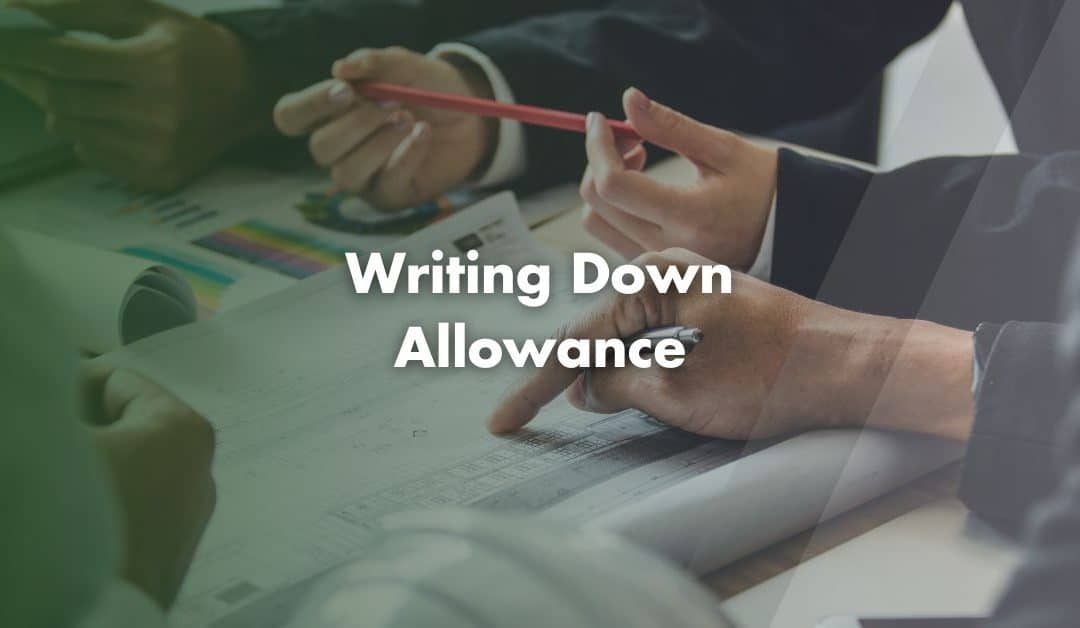When you purchase equipment or other assets for your business, they naturally decrease in value over time due to wear and tear. Rather than claiming the full cost of an asset upfront, Writing Down Allowance spreads the tax relief over several years.
Writing Down Allowances offer a tax-efficient way to reflect this depreciation. They are especially useful when your business exceeds its Annual Investment Allowance (AIA) limit or acquires items that do not qualify for AIA.
What is a Writing Down Allowance?
A Writing Down Allowance is a form of capital allowance that enables businesses to deduct a percentage of an asset’s value from their taxable profits each year.
While AIA and First-Year Allowances offer immediate deductions, a Writing Down Allowance delivers relief in smaller, annual instalments. This reducing balance method allows for greater relief in the earlier years of an asset’s life, tapering off as the asset loses efficiency or value.
When Can You Use Writing Down Allowances?
You can use Writing Down Allowance if:
- Your total capital spend exceeds the AIA threshold
- The asset is excluded from AIA (such as cars or gifted items)
- The item was personally owned before being used in the business
Writing Down Allowances offer flexibility and ensure businesses continue to benefit from tax relief, even when other options are not available.
Different Asset Pools
HMRC requires you to group assets into specific “pools” based on their expected rate of depreciation. Each pool has its own applicable rate:
1. Main Rate Pool – 18%
Includes general equipment such as machinery, computers and tools. You can deduct 18% of the remaining value each year.
2. Special Rate Pool – 6%
For longer-life assets and integral building features such as:
- Solar panels and insulation
- Electrical, heating and air conditioning systems
- Cars emitting over 50g/km of CO2 (purchased new or used, excluding zero-emission cars)
3. Single Asset Pools – 18% or 6%
Assets go into this pool if:
- You intend to use them for fewer than eight years (short-life assets)
- You use the item partly for personal reasons (relevant for sole traders and partnerships)
Private use reduces the amount you can claim but does not change the amount deducted from the pool.
Small Pools Allowance
If your main or special rate pool has a balance of £1,000 or less at the end of the year, you can claim the entire remaining amount as a full deduction. This is the Small Pools Allowance and should simplify tax returns for smaller businesses.
Short Life Assets
If you plan to use or sell an asset within eight years, you can choose to treat it as a short-life asset.
- Limited Companies must make this election within two years of the end of the accounting period in which they purchased the asset
- Sole Traders and Partnerships must make the election by 31st January following the end of the next tax year
- Assets in the special rate pool (such as integral features) cannot be short-life assets
This method ensures quick and accurate tax relief, especially when you dispose of the asset early.
Private Use
If you are a sole trader or in a partnership, and you use a business asset for personal reasons, you must exclude the private use portion from your claim.
For example: You buy a computer for £10,000 and use it 50% for business. The full Writing Down Allowance is £1,800 (18%), but only £900 can be claimed. Still, £1,800 is deducted from the pool balance to reflect depreciation.
How to Work Out Your Writing Down Allowance
Follow these steps to calculate your Writing Down Allowance:
- Start with the pool’s opening balance from the previous year
- Add qualifying purchases
- Subtract any disposals or items no longer in use
- Apply the appropriate rate (18% or 6%) to the result
- Deduct that amount from your taxable profits
The remaining balance becomes the “tax written down value” for the next year.
- Adjusted Balance – £10,000
- Claim at 18% – £1,800
- New Balance – £8,200
For example: You begin with £9,000 in your pool. You add machinery worth £1,200 and subtract a desk you sold for £200.
Writing Down Allowances on Business Cars
Business cars follow specific Writing Down Allowance rules and are not eligible for AIA. The rate depends on the vehicle’s CO2 emissions:
- 100% First-Year Allowance – only for new and unused zero-emission/electric vehicles; available until 31st March 2026 (Limited Companies) or 5th April 2026 (Sole Traders and Partnerships)
- 18% Main Rate – for cars with CO2 emissions of 50g/km or less
- 6% Special Rate – for cars over 50g/km
If you use the car privately, reduce your claim in proportion to the personal use.
For example: 30% personal use means only 70% of the Writing Down Allowance is claimable.
Claiming Your Writing Down Allowance
You must include your Writing Down Allowance claims in your tax return. To claim:
- Identify eligible assets
- Allocate each to the correct pool
- Calculate the Writing Down Allowance for each pool
- Deduct the total from your taxable profits
- Retain accurate records for HMRC
Contact Us
We are not just accountants; we are Chartered Accountants with one of the most reputable and premium accounting bodies. We are registered and regulated by ACCA; so you can rest assured that you are in good hands. Knowing this, don’t hesitate to get in touch with us if you require assistance: Pi Accountancy | Contact Us
This article is for general informational purposes only and does not constitute legal or financial advice. While we aim to keep our content up to date and accurate, UK tax laws and regulations are subject to change. Please speak to an accountant or tax professional for advice tailored to your individual circumstances. Pi Accountancy accepts no responsibility for any issues arising from reliance on the information provided.

